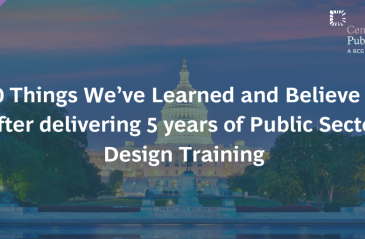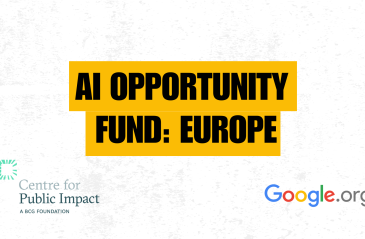
10 things we’ve learned and believe in after delivering 5 years of Public Sector Design Training

.@Dan_Vogel & @DannyWerfel share the main themes from the @BCG & @CPI_foundation roundtable on the US' #COVID19 response
Share article.@BCG @CPI_foundation roundtable w/ leaders @ the coalface of #COVID19 response revealed the importance of collabs, innovation & clear comms
Share article"It is clear that the longstanding racial inequities that COVID-19 has exacerbated are likely to keep growing if they are not addressed"
Share articleWe put our vision for government into practice through learning partner projects that align with our values and help reimagine government so that it works for everyone.
More than six months into the Covid-19 crisis in the U.S., we have seen multiple missteps, but have also seen leaders in the private and social sectors, and state and local governments step up.
Boston Consulting Group (BCG) and the Centre for Public Impact (CPI) recently co-organized a virtual roundtable bringing together eminent public and private sector, and civil society leaders at the coalface of the response effort as the U.S. grapples with the triple whammy of an economic, healthcare and social crisis, to discuss how the pandemic has been handled so far and how leaders need to prepare to chart an uncertain 2021.
Three themes emerged:
Governments, businesses and civil society across America have come together during these unprecedented times, rival firms have collaborated on the production of essential healthcare equipment such as PPE and ventilators, while bi-partisan partnerships have been formed at city, state, national and even international level, with the sharing of ideas and resources, in a concerted effort to tackle the virus.
Among the biggest success stories have been the roll out of test and trace centers across the country. City and state leaders together with private sector and civil society leaders have taken the lead here, harnessing innovation, data and technology as they try and adapt to the ever-evolving situation. There are many examples around, but the two that stand out are:
How Rhode Island's state government partnered with the private sector, allowing them to increase access to testing, tracing and tracking, and improved their ability to innovate fast. The state has now ramped up its testing to 1,500 people per day - the highest number in the U.S. - with less than one percent of those tested found to be positive, enabling a safe return to school and work. This level of testing was only possible due to help from CVS and Salesforce, and the government's swift uptake of the technology.
Rockefeller Foundation's efforts to fill the void by coordinating with states to ramp up testing to 30 million tests per week.
The most successful strategy for combating the virus to date, undoubtedly, has been to evaluate how the problem is being dealt with within the community and come up with innovative solutions to help tackle it locally. This involves quickly testing and experimenting with new ideas, learning from mistakes made, improving upon them, and communicating openly with government teams and residents.
Within government teams, systems and processes must be redesigned to promote recognition and response to the failures that are inevitable in any rapidly evolving, complex situation . This speeds up government's ability to innovate and improve results. In order to make this happen, governments need to move away from a fear of failure.
The most successful strategy for combating the virus to date, undoubtedly, has been to evaluate how the problem is being dealt with within the community and come up with innovative solutions to help tackle it locally.
Externally, it is imperative that governments communicate openly, honestly, and clearly with residents when recommendations change or evolve. This engenders trust with the public and enforces the legitimacy of the government's decision-making. By building a broad reservoir of support, governments are better able to innovate for better solutions while ensuring public adherence to future guidance.
Despite the scale and complexity of the pandemic, many city and state leaders must be commended for how swiftly they have responded to it. There is an opportunity to use this pandemic as a catalyst for revamping how they operate and embrace systems thinking and agile ways of working.
Covid-19 has posed tough questions about critical infrastructure. It has prompted us to take a step back and look hard at the U.S. healthcare and education systems through a different lens, focusing on those most at risk from the pandemic, namely minorities and young people.
BCG's research shows that the chief reasons for the disproportionate number of deaths are the greater risk of exposure to people with Covid-19 and less access to Covid-19 testing, accounting for about 85% of the disparity.
The long-term consequences of the pandemic for people of color are yet to be determined. But it is clear that the longstanding racial inequities that it has exacerbated are likely to keep growing if they are not addressed.
Governments need to ensure that they receive extensive testing and get access to quality healthcare. Community service centers, schools and historically black colleges and universities (HBCUs) can also play a vital role in providing tests and recruiting people for clinical trials.
Children and young people may not be vulnerable from a health perspective, but are bearing the burden in other ways. In response, Save the Children, with support from a range of public and private partners, delivered food to vulnerable children across the U.S., using school buses to get it to their doorsteps.
Besides families suffering economically and socially, due to school closures, children have also effectively missed out on six months of learning. To help address the problem, schools and local governments must prioritize safely bringing back children from low-income families who don't have access to basic learning resources such as the Internet.
Leaders at the roundtable provided a realistic view of the difficulties that lie ahead, particularly in vaccine distribution. Government, business and civil society leaders must play a much bigger part, particularly in the co-ordinated development and distribution of a vaccine in the coming months.
U.S. government and global institutions have already committed $5.8 billion towards vaccine development. Given the gravity of the situation, trials have been fast-tracked, with the development timeframe, which typically takes more than five years, being reduced to 12-18 months for the start of phased approvals.
To support the work being done at state level, there is also an urgent need to have a co-ordinated Federal plan for the distribution of a vaccine, drawing on lessons learned from the initial response. This plan must focus on protecting vulnerable people as a priority.
Six potential vaccines are already in phase three trials to determine their safety and efficacy, some of which may get emergency use authorization as early as the fourth quarter. In the best-case scenario, we forecast that the U.S. could commence widespread distribution in the second quarter of 2021.
To support the work being done at state level, there is also an urgent need to have a co-ordinated Federal plan for the distribution of a vaccine, drawing on lessons learned from the initial response. This plan must focus on protecting vulnerable people as a priority. While speed is of the essence when dealing with a pandemic of this magnitude, leaders must also consider complementary therapies, supply chain readiness and the public response in terms of adoption rates and continuing to maintain vigilance.
***
This is an opportunity to redefine our systems to protect the most vulnerable people in society and create a more equitable society as we recover from this pandemic. Public authorities need to continue working in partnership with the private sector to address the widespread social and economic fractures that have been laid bare by the pandemic, in the move towards a more equitable society.











